
Keyun Lu Station is a station on Line 5 of the Guangzhou Metro. It is located at the under the junction of Huangpu Avenue Middle (黄埔大道中) and Keyun Road (科韵路) in the Tianhe District, near Tianhe Science and Technology Park (天河科技园). It opened on 28 December 2009.

Tianhenan Station, formerly Tianhe 1st Road South Station (天河南一路站) during planning, is a metro station on the Guangzhou Metro APM line. It is located under the interchange of Tianhe 1st South Road (天河南一路) and Liuyun 2nd Street (六运二街) in the Tianhe District. It started operation on 8 November 2010. The station is unique in being the only station in Guangzhou with no escalator access to the platforms - instead 4 lifts carry passengers from the concourse to the platform although there is a staircase for emergency use.

Xinjiekou station is an interchange station between Line 1, Line 2 and Line 6 of the Nanjing Metro. It is located in Xinjiekou, the central business and commercial district of Nanjing. The largest and busiest station in the system, Xinjiekou station has 25 officially marked exits. On 30 September 2016 the station served a peak volume of 130,500 passengers. Trains here stop for 55 seconds, the longest stop at a non-terminus station in a mainland Chinese metro system.
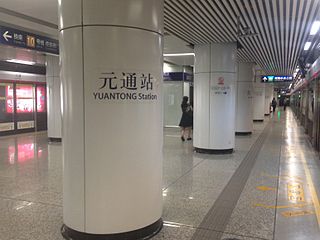
Yuantong station, also known as the Nanjing International Expo Centre Station, is an interchange station between Line 2 and Line 10 of the Nanjing Metro. The Line 10 station began operations on 3 September 2005 as part of Line 1's Phase I that ran from Maigaoqiao to Olympic Stadium, while the interchange with Line 2 opened when that line opened on 28 May 2010. On 1 July 2014, with the opening of Line 10, the former branch of Line 1 from Andemen to Olympic Stadium became re-designated as Line 10.

Zhongsheng station is a railway station on Line 10 of the Nanjing Metro. When it began operations on 3 September 2005, it was part of Nanjing Metro Line 1's Phase I from Maigaoqiao to Olympic Stadium. On 1 July 2014, with the opening of Line 10, the former branch of Line 1 from Andemen to Olympic Stadium became re-designated as Line 10.
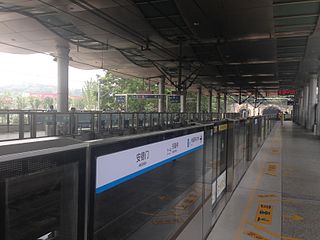
Andemen station, is a transfer station of Line 1 and Line 10 of the Nanjing Metro. It started operations on 3 September 2005 as part of Line 1's Phase I that ran north to Maigaoqiao; the previous branch of Line 1 from this station to Olympic Stadium was re-designated as Line 10 when that line opened on 1 July 2014, and Andemen became the eastern terminus of Line 10.

Xiaohang station, is a station of Line 10 of the Nanjing Metro. It started operations on 3 September 2005 as part of Line 1's Phase I that ran from Maigaoqiao to Olympic Stadium. On 1 July 2014, with the opening of Line 10, the former branch of Line 1 from Andemen to Olympic Stadium became re-designated as Line 10.

Olympic Stadium station, is a station of Line 10 of the Nanjing Metro. It started operations on 3 September 2005 as part of Line 1's Phase I that ran from Maigaoqiao to this station, On 1 July 2014, with the opening of Line 10, the former branch of Line 1 from Andemen to this station became re-designated as Line 10.

Tianlongsi station, is a station of Line 1 of the Nanjing Metro. It began operations on 28 May 2010, as part of the southern extension of line 1 from Andemen to CPU.

Tianyindadao station, is a station of Line 1 of the Nanjing Metro. It began operations on 28 May 2010, as part of the southern extension of line 1 from Andemen to CPU.

Olympic Stadium East station, formerly Xiangxinglu station during planning until 2007, is a station of Line 2 of the Nanjing Metro. It started operations on 28 May 2010 along with the rest of Line 2. On 30 September 2016 the station served a peak volume of 31,300 passengers.

Jingtianlu station, is a station and the eastern terminus of Line 2 of the Nanjing Metro. It started operations on 28 May 2010 along with the rest of Line 2.

Dongmenkou Station, or Dongmenkou Station, or literally East Gate Station, is a metro station on Line 1 of the Ningbo Rail Transit that started operations on 30 May 2014. It is situated under Zhongshan East Road in the Haishu District of Ningbo City, Zhejiang Province, eastern China.
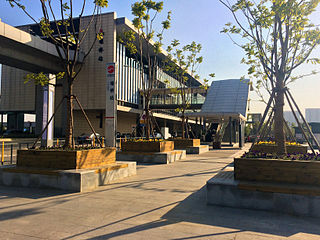
Yanqiao Station is a metro station on Line 1 of the Wuxi Metro. It began operations on 1 July 2014. The station is reserved for Xincheng Urban Line (锡澄市域轨道交通线) services towards Jiangyin.

Liutan Station, is a metro station of Line 1, Wuxi Metro. It started operations on 1 July 2014. It is the future terminus of Line 4.
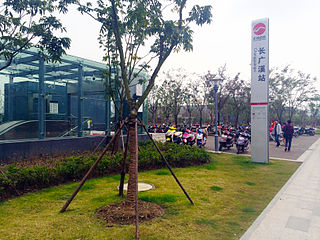
Changguangxi Station, is the eastern terminus of Line 1, Wuxi Metro. It started operations on 1 July 2014.

Meiyuan Kaiyuan Temple Station, is the western terminus of Line 2, Wuxi Metro. It started operations on 28 December 2014. The station is near The Plum Garden.
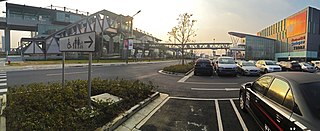
Yunlin Station, is a metro station of Line 2, Wuxi Metro. It started operations on 28 December 2014. The station is near Wuxi IKEA Store, B&Q, Decathlon.

Jiulihe Park Station, is a metro station of Line 2, Wuxi Metro. It started operations on 28 December 2014.
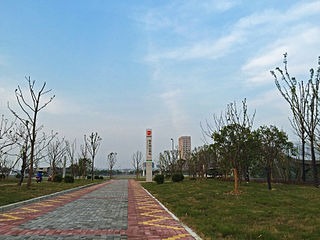
Yingyuehu Park Station Station, is a metro station of Line 2, Wuxi Metro. It started operations on 28 April 2015. It will be the terminus of line 4.























